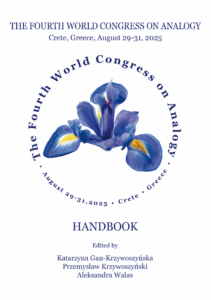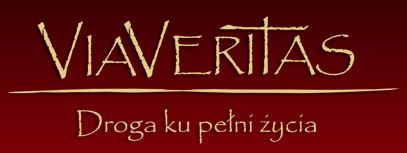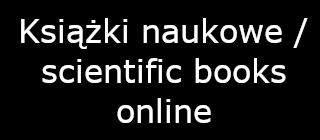In preparation / w przygotowaniu: Handbook of the Fourth World Congress on Analogy Crete, Greece, August 29-31, 2025 / podręcznik Czwartego Światowego Kongresu na temat Analogii na Krecie, Grecja, 29-31 sierpnia 2025
 |
Handbook of the Fourth World Congress on Analogy
Crete, Greece, August 29-31, 2025 Edited by / pod redakcją Issue / wydanie: first /pierwsze
Year of publication / rok wydania: 2025
Binding / oprawa: soft / miękka Volume / objętość: 82 pages / strony Format: 148×210 mm Category / kategoria: Philosophy / filozofia Language / język: English / angielski
ISBN 978-83-68332-10-0
PEER-REVIEWED SCIENTIFIC PAPER / RECENZOWANE OPRACOWANIE NAUKOWE
|
This year, with the Fourth World Congress on Analogy, we celebrate the project’s tenth year. We began in 2015 in Puebla, Mexico (see the handbook of The First World Congress on Analogy), continued in 2017 in Poznań (see the website of The Second World Congress on Analogy), and, after the pandemic, resumed in 2023 in Puebla (see the website of The Third World Congress on Analogy). Meanwhile, during the 7th World Congress and School on Universal Logic (UNILOG 2022), we organised a Tutorial and a Workshop.
The logo of this edition of the congress is the gorgeous Cretan iris (Iris cretensis), a flower rich in beautiful symbolism that reflects the fundamental role of analogy in dialogue and communication. The Greek goddess Iris was a messenger between the gods, as well as between gods and people.
This golden-winged goddess, on the one hand, is not a main character in mythology; on the other hand, she plays a very important role in many stories and was given many difficult tasks. What is particularly interesting in the context of analogy is that she delivered both good and bad messages. We believe it is always beneficial to face the truth and understand both positive and negative similarities and differences. The gorgeous Iris also reminds us of respect for the herald.
This goddess is always represented in shining (also “iridescent”) colours. Iris in Greek ( Ἶρις) means “rainbow” – joining heaven and earth. The Spanish word for rainbow is arcoíris. Moreover, in English, iris is the colourful part of the eye of all mammals and birds, unique to each individual, and may provide insights into health and emotions.
During this jubilee edition of the Congress we also want to celebrate slow (in the sense of “slow movement”) and analogue (as opposed to digital) communication.
So let’s take our time to celebrate analogies – i.e. shining, colourful bridges – as a basis for dialogue in three spheres (following Martin Buber): in our life with nature, with people, and with intelligible forms.
Podręcznik Czwartego Światowego Kongresu na temat Analogii na Krecie w Grecji w sierpniu 2025 r.
W tym roku, wraz z Czwartym Światowym Kongresem Analogii, obchodzimy dziesiąty rok projektu. Rozpoczęliśmy w 2015 roku w Puebli w Meksyku (zobacz podręcznik Pierwszego Światowego Kongresu Analogii), kontynuowaliśmy w 2017 roku w Poznaniu (zobacz stronę internetową Drugiego Światowego Kongresu Analogii), a po pandemii wznowiliśmy w 2023 roku w Puebli (zobacz stronę internetową Trzeciego Światowego Kongresu Analogii). Tymczasem, podczas VII Światowego Kongresu i Szkoły Logiki Uniwersalnej (UNILOG 2022), zorganizowaliśmy Tutorial i Warsztat. Logo tej edycji kongresu to przepiękny kreteński irys (Iris cretensis), kwiat bogaty w piękną symbolikę, odzwierciedlający fundamentalną rolę analogii w dialogu i komunikacji. Grecka bogini Iris była posłańcem między bogami, a także między bogami a ludźmi. Ta złotoskrzydła bogini, z jednej strony, nie jest główną bohaterką mitologii; z drugiej strony, odgrywa bardzo ważną rolę w wielu opowieściach i otrzymała wiele trudnych zadań. Szczególnie interesujące w kontekście analogii jest to, że przekazywała zarówno dobre, jak i złe przesłania. Wierzymy, że zawsze warto stawić czoła prawdzie i zrozumieć zarówno pozytywne, jak i negatywne podobieństwa i różnice. Piękna Iris przypomina nam również o szacunku dla herolda. Bogini ta jest zawsze przedstawiana w lśniących (również „opalizujących”) barwach. Iris w języku greckim ( Ἶρις) oznacza „tęczę” – łączącą niebo i ziemię. Hiszpańskie słowo oznaczające tęczę to arcoíris. Co więcej, w języku angielskim iris to kolorowa część oka wszystkich ssaków i ptaków, unikalna dla każdego osobnika, która może dostarczać wglądu w zdrowie i emocje. Podczas tej jubileuszowej edycji Kongresu chcemy również celebrować powolną (w znaczeniu „powolnego ruchu”) i analogową (w przeciwieństwie do cyfrowej) komunikację. Poświęćmy więc chwilę na świętowanie analogii – tzn. błyszczących, kolorowych mostów – jako podstawy dialogu w trzech sferach (za Martinem Buberem): w naszym życiu z naturą, z ludźmi i z formami zrozumiałymi.



